Nursing Assignment: Clinical Reasoning Cycle and Patient Care Plan
VerifiedAdded on 2023/01/11
|7
|2595
|97
AI Summary
This nursing assignment discusses the importance of the clinical reasoning cycle in developing a patient care plan. It focuses on a case study of a patient with Type II Diabetes and obesity, and explores how improper management of these conditions led to additional comorbidities. The assignment also highlights the nursing interventions and goals for the patient, as well as the evaluation and reflection process.
Contribute Materials
Your contribution can guide someone’s learning journey. Share your
documents today.
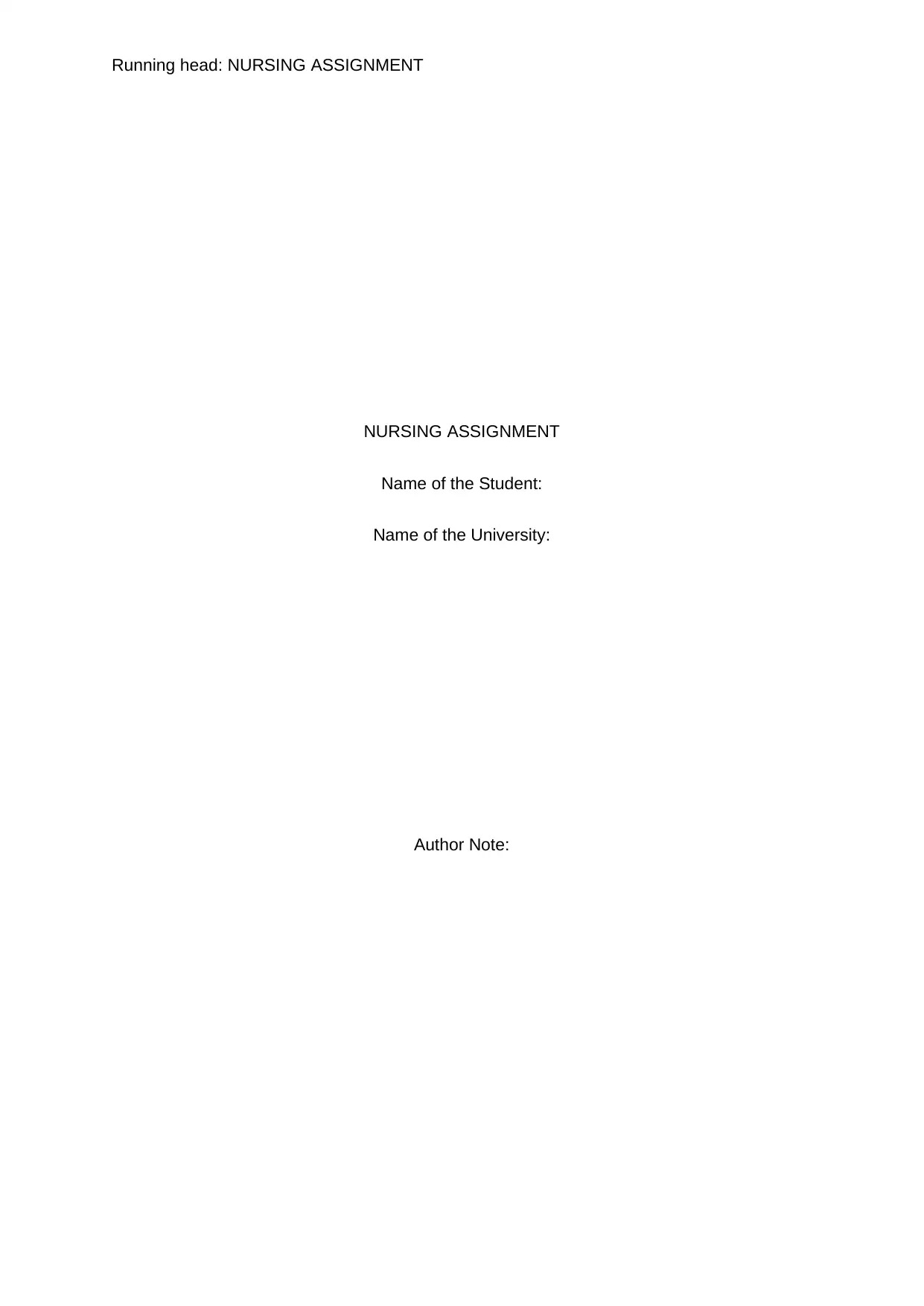
Running head: NURSING ASSIGNMENT
NURSING ASSIGNMENT
Name of the Student:
Name of the University:
Author Note:
NURSING ASSIGNMENT
Name of the Student:
Name of the University:
Author Note:
Secure Best Marks with AI Grader
Need help grading? Try our AI Grader for instant feedback on your assignments.
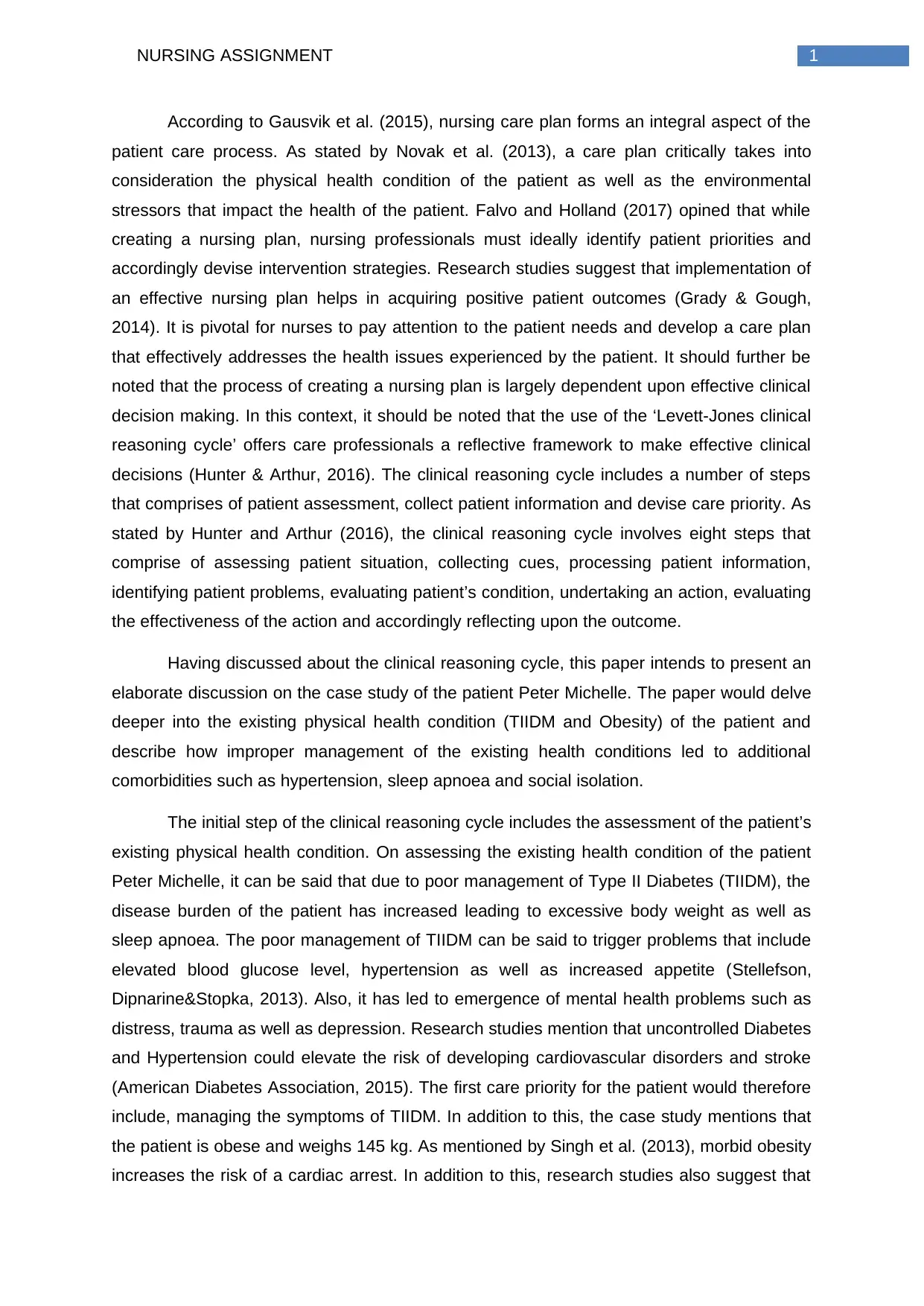
1NURSING ASSIGNMENT
According to Gausvik et al. (2015), nursing care plan forms an integral aspect of the
patient care process. As stated by Novak et al. (2013), a care plan critically takes into
consideration the physical health condition of the patient as well as the environmental
stressors that impact the health of the patient. Falvo and Holland (2017) opined that while
creating a nursing plan, nursing professionals must ideally identify patient priorities and
accordingly devise intervention strategies. Research studies suggest that implementation of
an effective nursing plan helps in acquiring positive patient outcomes (Grady & Gough,
2014). It is pivotal for nurses to pay attention to the patient needs and develop a care plan
that effectively addresses the health issues experienced by the patient. It should further be
noted that the process of creating a nursing plan is largely dependent upon effective clinical
decision making. In this context, it should be noted that the use of the ‘Levett-Jones clinical
reasoning cycle’ offers care professionals a reflective framework to make effective clinical
decisions (Hunter & Arthur, 2016). The clinical reasoning cycle includes a number of steps
that comprises of patient assessment, collect patient information and devise care priority. As
stated by Hunter and Arthur (2016), the clinical reasoning cycle involves eight steps that
comprise of assessing patient situation, collecting cues, processing patient information,
identifying patient problems, evaluating patient’s condition, undertaking an action, evaluating
the effectiveness of the action and accordingly reflecting upon the outcome.
Having discussed about the clinical reasoning cycle, this paper intends to present an
elaborate discussion on the case study of the patient Peter Michelle. The paper would delve
deeper into the existing physical health condition (TIIDM and Obesity) of the patient and
describe how improper management of the existing health conditions led to additional
comorbidities such as hypertension, sleep apnoea and social isolation.
The initial step of the clinical reasoning cycle includes the assessment of the patient’s
existing physical health condition. On assessing the existing health condition of the patient
Peter Michelle, it can be said that due to poor management of Type II Diabetes (TIIDM), the
disease burden of the patient has increased leading to excessive body weight as well as
sleep apnoea. The poor management of TIIDM can be said to trigger problems that include
elevated blood glucose level, hypertension as well as increased appetite (Stellefson,
Dipnarine&Stopka, 2013). Also, it has led to emergence of mental health problems such as
distress, trauma as well as depression. Research studies mention that uncontrolled Diabetes
and Hypertension could elevate the risk of developing cardiovascular disorders and stroke
(American Diabetes Association, 2015). The first care priority for the patient would therefore
include, managing the symptoms of TIIDM. In addition to this, the case study mentions that
the patient is obese and weighs 145 kg. As mentioned by Singh et al. (2013), morbid obesity
increases the risk of a cardiac arrest. In addition to this, research studies also suggest that
According to Gausvik et al. (2015), nursing care plan forms an integral aspect of the
patient care process. As stated by Novak et al. (2013), a care plan critically takes into
consideration the physical health condition of the patient as well as the environmental
stressors that impact the health of the patient. Falvo and Holland (2017) opined that while
creating a nursing plan, nursing professionals must ideally identify patient priorities and
accordingly devise intervention strategies. Research studies suggest that implementation of
an effective nursing plan helps in acquiring positive patient outcomes (Grady & Gough,
2014). It is pivotal for nurses to pay attention to the patient needs and develop a care plan
that effectively addresses the health issues experienced by the patient. It should further be
noted that the process of creating a nursing plan is largely dependent upon effective clinical
decision making. In this context, it should be noted that the use of the ‘Levett-Jones clinical
reasoning cycle’ offers care professionals a reflective framework to make effective clinical
decisions (Hunter & Arthur, 2016). The clinical reasoning cycle includes a number of steps
that comprises of patient assessment, collect patient information and devise care priority. As
stated by Hunter and Arthur (2016), the clinical reasoning cycle involves eight steps that
comprise of assessing patient situation, collecting cues, processing patient information,
identifying patient problems, evaluating patient’s condition, undertaking an action, evaluating
the effectiveness of the action and accordingly reflecting upon the outcome.
Having discussed about the clinical reasoning cycle, this paper intends to present an
elaborate discussion on the case study of the patient Peter Michelle. The paper would delve
deeper into the existing physical health condition (TIIDM and Obesity) of the patient and
describe how improper management of the existing health conditions led to additional
comorbidities such as hypertension, sleep apnoea and social isolation.
The initial step of the clinical reasoning cycle includes the assessment of the patient’s
existing physical health condition. On assessing the existing health condition of the patient
Peter Michelle, it can be said that due to poor management of Type II Diabetes (TIIDM), the
disease burden of the patient has increased leading to excessive body weight as well as
sleep apnoea. The poor management of TIIDM can be said to trigger problems that include
elevated blood glucose level, hypertension as well as increased appetite (Stellefson,
Dipnarine&Stopka, 2013). Also, it has led to emergence of mental health problems such as
distress, trauma as well as depression. Research studies mention that uncontrolled Diabetes
and Hypertension could elevate the risk of developing cardiovascular disorders and stroke
(American Diabetes Association, 2015). The first care priority for the patient would therefore
include, managing the symptoms of TIIDM. In addition to this, the case study mentions that
the patient is obese and weighs 145 kg. As mentioned by Singh et al. (2013), morbid obesity
increases the risk of a cardiac arrest. In addition to this, research studies also suggest that
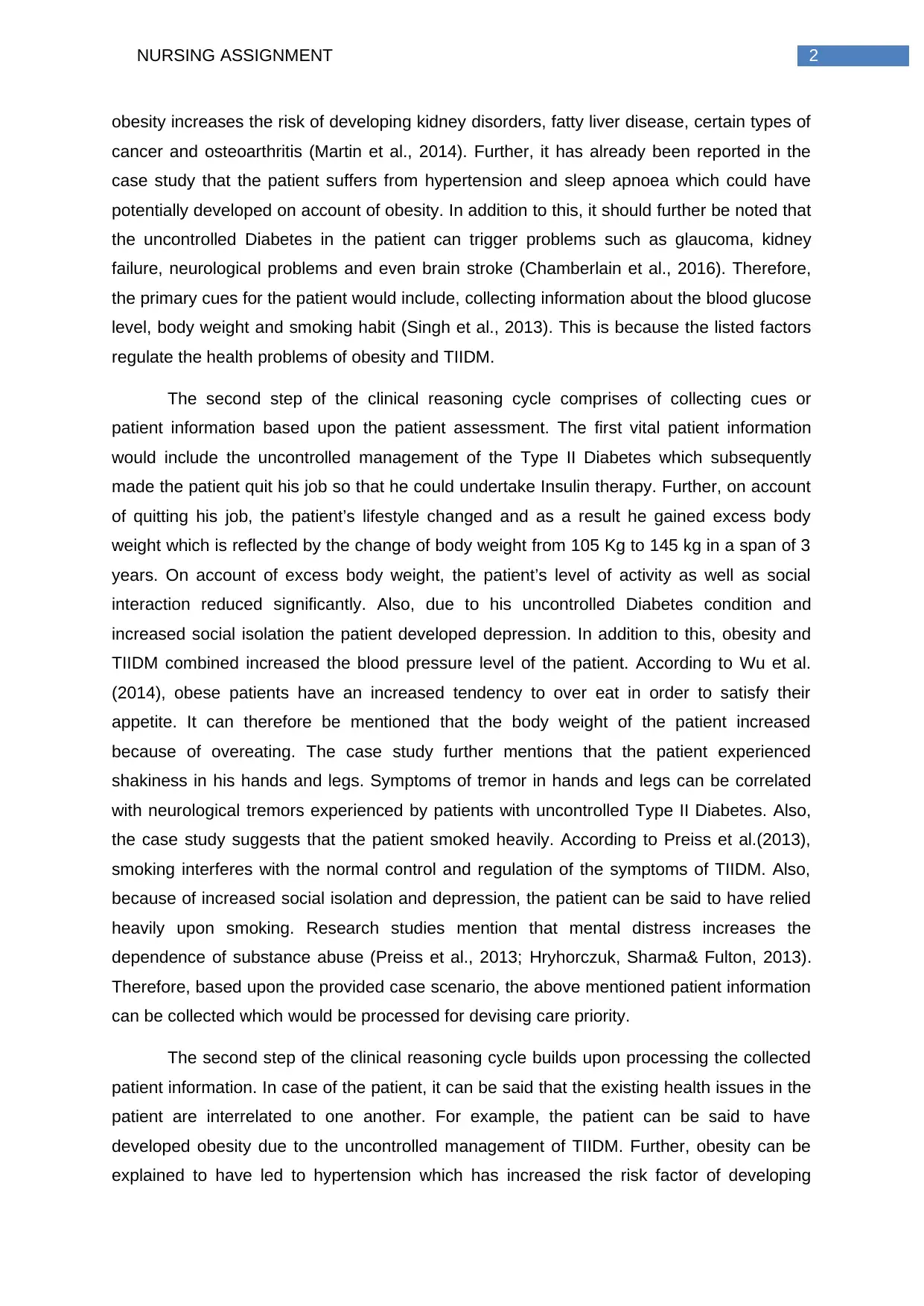
2NURSING ASSIGNMENT
obesity increases the risk of developing kidney disorders, fatty liver disease, certain types of
cancer and osteoarthritis (Martin et al., 2014). Further, it has already been reported in the
case study that the patient suffers from hypertension and sleep apnoea which could have
potentially developed on account of obesity. In addition to this, it should further be noted that
the uncontrolled Diabetes in the patient can trigger problems such as glaucoma, kidney
failure, neurological problems and even brain stroke (Chamberlain et al., 2016). Therefore,
the primary cues for the patient would include, collecting information about the blood glucose
level, body weight and smoking habit (Singh et al., 2013). This is because the listed factors
regulate the health problems of obesity and TIIDM.
The second step of the clinical reasoning cycle comprises of collecting cues or
patient information based upon the patient assessment. The first vital patient information
would include the uncontrolled management of the Type II Diabetes which subsequently
made the patient quit his job so that he could undertake Insulin therapy. Further, on account
of quitting his job, the patient’s lifestyle changed and as a result he gained excess body
weight which is reflected by the change of body weight from 105 Kg to 145 kg in a span of 3
years. On account of excess body weight, the patient’s level of activity as well as social
interaction reduced significantly. Also, due to his uncontrolled Diabetes condition and
increased social isolation the patient developed depression. In addition to this, obesity and
TIIDM combined increased the blood pressure level of the patient. According to Wu et al.
(2014), obese patients have an increased tendency to over eat in order to satisfy their
appetite. It can therefore be mentioned that the body weight of the patient increased
because of overeating. The case study further mentions that the patient experienced
shakiness in his hands and legs. Symptoms of tremor in hands and legs can be correlated
with neurological tremors experienced by patients with uncontrolled Type II Diabetes. Also,
the case study suggests that the patient smoked heavily. According to Preiss et al.(2013),
smoking interferes with the normal control and regulation of the symptoms of TIIDM. Also,
because of increased social isolation and depression, the patient can be said to have relied
heavily upon smoking. Research studies mention that mental distress increases the
dependence of substance abuse (Preiss et al., 2013; Hryhorczuk, Sharma& Fulton, 2013).
Therefore, based upon the provided case scenario, the above mentioned patient information
can be collected which would be processed for devising care priority.
The second step of the clinical reasoning cycle builds upon processing the collected
patient information. In case of the patient, it can be said that the existing health issues in the
patient are interrelated to one another. For example, the patient can be said to have
developed obesity due to the uncontrolled management of TIIDM. Further, obesity can be
explained to have led to hypertension which has increased the risk factor of developing
obesity increases the risk of developing kidney disorders, fatty liver disease, certain types of
cancer and osteoarthritis (Martin et al., 2014). Further, it has already been reported in the
case study that the patient suffers from hypertension and sleep apnoea which could have
potentially developed on account of obesity. In addition to this, it should further be noted that
the uncontrolled Diabetes in the patient can trigger problems such as glaucoma, kidney
failure, neurological problems and even brain stroke (Chamberlain et al., 2016). Therefore,
the primary cues for the patient would include, collecting information about the blood glucose
level, body weight and smoking habit (Singh et al., 2013). This is because the listed factors
regulate the health problems of obesity and TIIDM.
The second step of the clinical reasoning cycle comprises of collecting cues or
patient information based upon the patient assessment. The first vital patient information
would include the uncontrolled management of the Type II Diabetes which subsequently
made the patient quit his job so that he could undertake Insulin therapy. Further, on account
of quitting his job, the patient’s lifestyle changed and as a result he gained excess body
weight which is reflected by the change of body weight from 105 Kg to 145 kg in a span of 3
years. On account of excess body weight, the patient’s level of activity as well as social
interaction reduced significantly. Also, due to his uncontrolled Diabetes condition and
increased social isolation the patient developed depression. In addition to this, obesity and
TIIDM combined increased the blood pressure level of the patient. According to Wu et al.
(2014), obese patients have an increased tendency to over eat in order to satisfy their
appetite. It can therefore be mentioned that the body weight of the patient increased
because of overeating. The case study further mentions that the patient experienced
shakiness in his hands and legs. Symptoms of tremor in hands and legs can be correlated
with neurological tremors experienced by patients with uncontrolled Type II Diabetes. Also,
the case study suggests that the patient smoked heavily. According to Preiss et al.(2013),
smoking interferes with the normal control and regulation of the symptoms of TIIDM. Also,
because of increased social isolation and depression, the patient can be said to have relied
heavily upon smoking. Research studies mention that mental distress increases the
dependence of substance abuse (Preiss et al., 2013; Hryhorczuk, Sharma& Fulton, 2013).
Therefore, based upon the provided case scenario, the above mentioned patient information
can be collected which would be processed for devising care priority.
The second step of the clinical reasoning cycle builds upon processing the collected
patient information. In case of the patient, it can be said that the existing health issues in the
patient are interrelated to one another. For example, the patient can be said to have
developed obesity due to the uncontrolled management of TIIDM. Further, obesity can be
explained to have led to hypertension which has increased the risk factor of developing
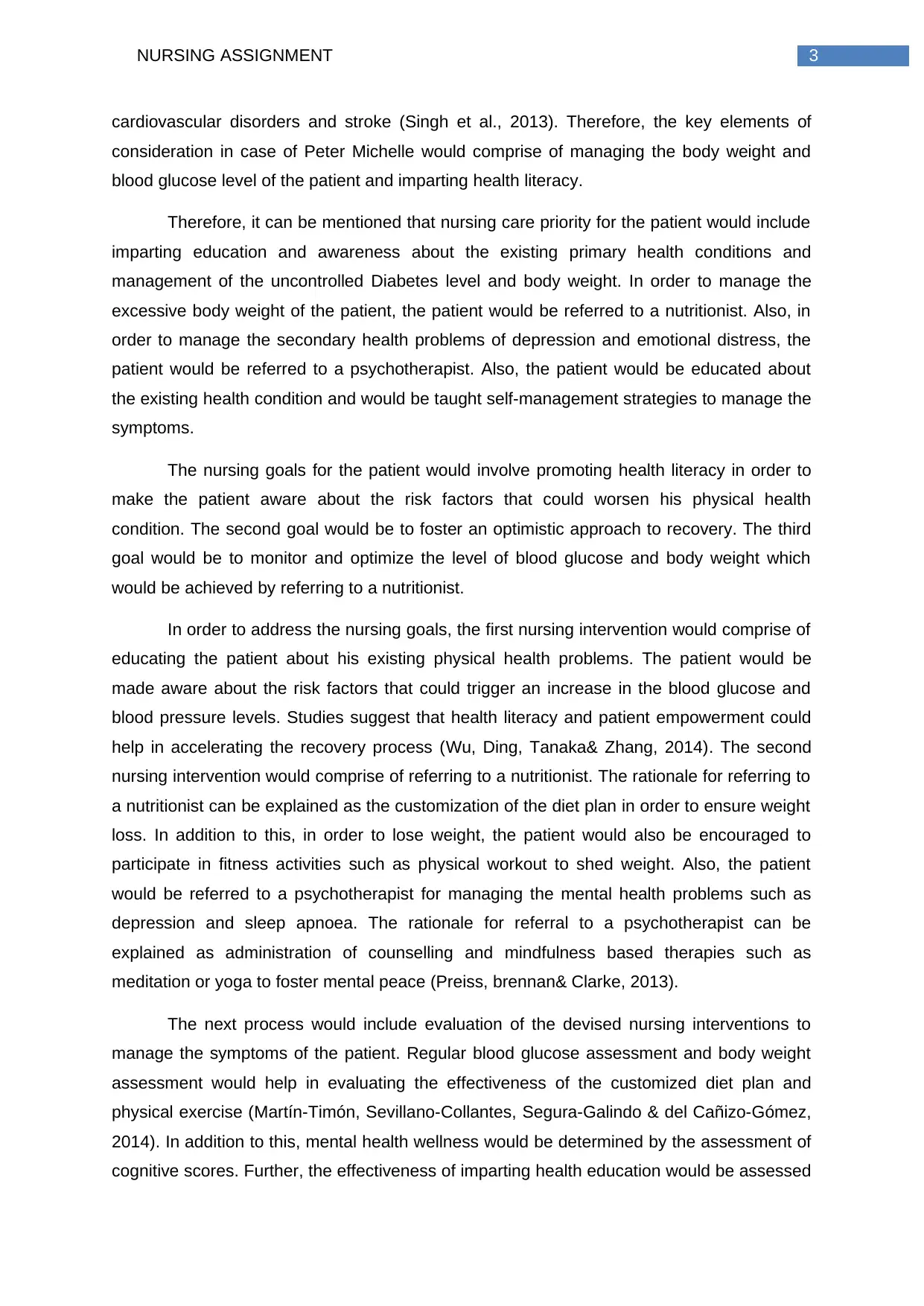
3NURSING ASSIGNMENT
cardiovascular disorders and stroke (Singh et al., 2013). Therefore, the key elements of
consideration in case of Peter Michelle would comprise of managing the body weight and
blood glucose level of the patient and imparting health literacy.
Therefore, it can be mentioned that nursing care priority for the patient would include
imparting education and awareness about the existing primary health conditions and
management of the uncontrolled Diabetes level and body weight. In order to manage the
excessive body weight of the patient, the patient would be referred to a nutritionist. Also, in
order to manage the secondary health problems of depression and emotional distress, the
patient would be referred to a psychotherapist. Also, the patient would be educated about
the existing health condition and would be taught self-management strategies to manage the
symptoms.
The nursing goals for the patient would involve promoting health literacy in order to
make the patient aware about the risk factors that could worsen his physical health
condition. The second goal would be to foster an optimistic approach to recovery. The third
goal would be to monitor and optimize the level of blood glucose and body weight which
would be achieved by referring to a nutritionist.
In order to address the nursing goals, the first nursing intervention would comprise of
educating the patient about his existing physical health problems. The patient would be
made aware about the risk factors that could trigger an increase in the blood glucose and
blood pressure levels. Studies suggest that health literacy and patient empowerment could
help in accelerating the recovery process (Wu, Ding, Tanaka& Zhang, 2014). The second
nursing intervention would comprise of referring to a nutritionist. The rationale for referring to
a nutritionist can be explained as the customization of the diet plan in order to ensure weight
loss. In addition to this, in order to lose weight, the patient would also be encouraged to
participate in fitness activities such as physical workout to shed weight. Also, the patient
would be referred to a psychotherapist for managing the mental health problems such as
depression and sleep apnoea. The rationale for referral to a psychotherapist can be
explained as administration of counselling and mindfulness based therapies such as
meditation or yoga to foster mental peace (Preiss, brennan& Clarke, 2013).
The next process would include evaluation of the devised nursing interventions to
manage the symptoms of the patient. Regular blood glucose assessment and body weight
assessment would help in evaluating the effectiveness of the customized diet plan and
physical exercise (Martín-Timón, Sevillano-Collantes, Segura-Galindo & del Cañizo-Gómez,
2014). In addition to this, mental health wellness would be determined by the assessment of
cognitive scores. Further, the effectiveness of imparting health education would be assessed
cardiovascular disorders and stroke (Singh et al., 2013). Therefore, the key elements of
consideration in case of Peter Michelle would comprise of managing the body weight and
blood glucose level of the patient and imparting health literacy.
Therefore, it can be mentioned that nursing care priority for the patient would include
imparting education and awareness about the existing primary health conditions and
management of the uncontrolled Diabetes level and body weight. In order to manage the
excessive body weight of the patient, the patient would be referred to a nutritionist. Also, in
order to manage the secondary health problems of depression and emotional distress, the
patient would be referred to a psychotherapist. Also, the patient would be educated about
the existing health condition and would be taught self-management strategies to manage the
symptoms.
The nursing goals for the patient would involve promoting health literacy in order to
make the patient aware about the risk factors that could worsen his physical health
condition. The second goal would be to foster an optimistic approach to recovery. The third
goal would be to monitor and optimize the level of blood glucose and body weight which
would be achieved by referring to a nutritionist.
In order to address the nursing goals, the first nursing intervention would comprise of
educating the patient about his existing physical health problems. The patient would be
made aware about the risk factors that could trigger an increase in the blood glucose and
blood pressure levels. Studies suggest that health literacy and patient empowerment could
help in accelerating the recovery process (Wu, Ding, Tanaka& Zhang, 2014). The second
nursing intervention would comprise of referring to a nutritionist. The rationale for referring to
a nutritionist can be explained as the customization of the diet plan in order to ensure weight
loss. In addition to this, in order to lose weight, the patient would also be encouraged to
participate in fitness activities such as physical workout to shed weight. Also, the patient
would be referred to a psychotherapist for managing the mental health problems such as
depression and sleep apnoea. The rationale for referral to a psychotherapist can be
explained as administration of counselling and mindfulness based therapies such as
meditation or yoga to foster mental peace (Preiss, brennan& Clarke, 2013).
The next process would include evaluation of the devised nursing interventions to
manage the symptoms of the patient. Regular blood glucose assessment and body weight
assessment would help in evaluating the effectiveness of the customized diet plan and
physical exercise (Martín-Timón, Sevillano-Collantes, Segura-Galindo & del Cañizo-Gómez,
2014). In addition to this, mental health wellness would be determined by the assessment of
cognitive scores. Further, the effectiveness of imparting health education would be assessed
Secure Best Marks with AI Grader
Need help grading? Try our AI Grader for instant feedback on your assignments.
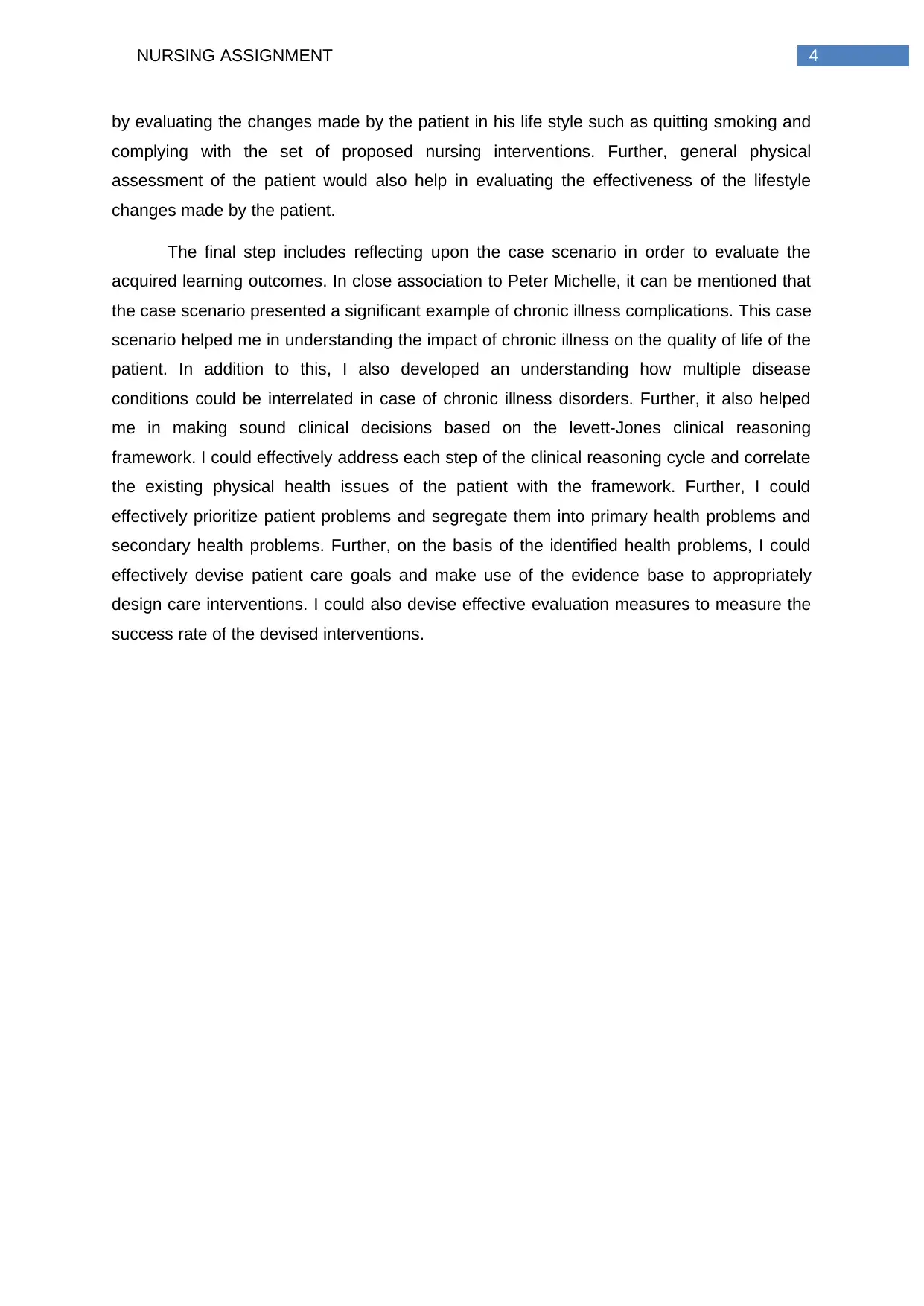
4NURSING ASSIGNMENT
by evaluating the changes made by the patient in his life style such as quitting smoking and
complying with the set of proposed nursing interventions. Further, general physical
assessment of the patient would also help in evaluating the effectiveness of the lifestyle
changes made by the patient.
The final step includes reflecting upon the case scenario in order to evaluate the
acquired learning outcomes. In close association to Peter Michelle, it can be mentioned that
the case scenario presented a significant example of chronic illness complications. This case
scenario helped me in understanding the impact of chronic illness on the quality of life of the
patient. In addition to this, I also developed an understanding how multiple disease
conditions could be interrelated in case of chronic illness disorders. Further, it also helped
me in making sound clinical decisions based on the levett-Jones clinical reasoning
framework. I could effectively address each step of the clinical reasoning cycle and correlate
the existing physical health issues of the patient with the framework. Further, I could
effectively prioritize patient problems and segregate them into primary health problems and
secondary health problems. Further, on the basis of the identified health problems, I could
effectively devise patient care goals and make use of the evidence base to appropriately
design care interventions. I could also devise effective evaluation measures to measure the
success rate of the devised interventions.
by evaluating the changes made by the patient in his life style such as quitting smoking and
complying with the set of proposed nursing interventions. Further, general physical
assessment of the patient would also help in evaluating the effectiveness of the lifestyle
changes made by the patient.
The final step includes reflecting upon the case scenario in order to evaluate the
acquired learning outcomes. In close association to Peter Michelle, it can be mentioned that
the case scenario presented a significant example of chronic illness complications. This case
scenario helped me in understanding the impact of chronic illness on the quality of life of the
patient. In addition to this, I also developed an understanding how multiple disease
conditions could be interrelated in case of chronic illness disorders. Further, it also helped
me in making sound clinical decisions based on the levett-Jones clinical reasoning
framework. I could effectively address each step of the clinical reasoning cycle and correlate
the existing physical health issues of the patient with the framework. Further, I could
effectively prioritize patient problems and segregate them into primary health problems and
secondary health problems. Further, on the basis of the identified health problems, I could
effectively devise patient care goals and make use of the evidence base to appropriately
design care interventions. I could also devise effective evaluation measures to measure the
success rate of the devised interventions.

5NURSING ASSIGNMENT
References:
American Diabetes Association. (2015). Standards of medical care in diabetes—2015
abridged for primary care providers. Clinical diabetes: a publication of the American
Diabetes Association, 33(2), 97. DOI: 10.2337/diaclin.33.2.97
Chamberlain, J. J., Rhinehart, A. S., Shaefer, C. F., &Neuman, A. (2016). Diagnosis and
management of diabetes: synopsis of the 2016 American Diabetes Association
Standards of Medical Care in Diabetes. Annals of internal medicine, 164(8), 542-
552.DOI: 10.7326/M15-3016
Falvo, D., & Holland, B. E. (2017). Medical and psychosocial aspects of chronic illness and
disability. Jones & Bartlett Learning.P.90. Retrieved from:
https://books.google.co.in/books?
hl=en&lr=&id=rXM1DgAAQBAJ&oi=fnd&pg=PR1&dq=chronic+illness&ots=oJ-
lM0OEEK&sig=3AleIZfE4XrEu-76h4sQ8nXTAko#v=onepage&q=chronic
%20illness&f=false
Gausvik, C., Lautar, A., Miller, L., Pallerla, H., &Schlaudecker, J. (2015). Structured nursing
communication on interdisciplinary acute care teams improves perceptions of safety,
efficiency, understanding of care plan and teamwork as well as job
satisfaction. Journal of multidisciplinary healthcare, 8, 33. DOI:
10.2147/JMDH.S72623
Grady, P. A., & Gough, L. L. (2014). Self-management: a comprehensive approach to
management of chronic conditions. American Journal of Public Health, 104(8), e25-
e31. Retrieved from:
https://ajph.aphapublications.org/doi/abs/10.2105/AJPH.2014.302041
Hryhorczuk, C., Sharma, S., & Fulton, S. E. (2013). Metabolic disturbances connecting
obesity and depression. Frontiers in neuroscience, 7, 177. DOI:
https://doi.org/10.3389/fnins.2013.00177
Hunter, S., & Arthur, C. (2016). Clinical reasoning of nursing students on clinical placement:
Clinical educators' perceptions. Nurse education in practice, 18, 73-79. DOI:
https://doi.org/10.1016/j.nepr.2016.03.002
Martín-Timón, I., Sevillano-Collantes, C., Segura-Galindo, A., &delCañizo-Gómez, F. J.
(2014). Type 2 diabetes and cardiovascular disease: have all risk factors the same
strength?. World journal of diabetes, 5(4), 444. DOI: 10.4239/wjd.v5.i4.444
References:
American Diabetes Association. (2015). Standards of medical care in diabetes—2015
abridged for primary care providers. Clinical diabetes: a publication of the American
Diabetes Association, 33(2), 97. DOI: 10.2337/diaclin.33.2.97
Chamberlain, J. J., Rhinehart, A. S., Shaefer, C. F., &Neuman, A. (2016). Diagnosis and
management of diabetes: synopsis of the 2016 American Diabetes Association
Standards of Medical Care in Diabetes. Annals of internal medicine, 164(8), 542-
552.DOI: 10.7326/M15-3016
Falvo, D., & Holland, B. E. (2017). Medical and psychosocial aspects of chronic illness and
disability. Jones & Bartlett Learning.P.90. Retrieved from:
https://books.google.co.in/books?
hl=en&lr=&id=rXM1DgAAQBAJ&oi=fnd&pg=PR1&dq=chronic+illness&ots=oJ-
lM0OEEK&sig=3AleIZfE4XrEu-76h4sQ8nXTAko#v=onepage&q=chronic
%20illness&f=false
Gausvik, C., Lautar, A., Miller, L., Pallerla, H., &Schlaudecker, J. (2015). Structured nursing
communication on interdisciplinary acute care teams improves perceptions of safety,
efficiency, understanding of care plan and teamwork as well as job
satisfaction. Journal of multidisciplinary healthcare, 8, 33. DOI:
10.2147/JMDH.S72623
Grady, P. A., & Gough, L. L. (2014). Self-management: a comprehensive approach to
management of chronic conditions. American Journal of Public Health, 104(8), e25-
e31. Retrieved from:
https://ajph.aphapublications.org/doi/abs/10.2105/AJPH.2014.302041
Hryhorczuk, C., Sharma, S., & Fulton, S. E. (2013). Metabolic disturbances connecting
obesity and depression. Frontiers in neuroscience, 7, 177. DOI:
https://doi.org/10.3389/fnins.2013.00177
Hunter, S., & Arthur, C. (2016). Clinical reasoning of nursing students on clinical placement:
Clinical educators' perceptions. Nurse education in practice, 18, 73-79. DOI:
https://doi.org/10.1016/j.nepr.2016.03.002
Martín-Timón, I., Sevillano-Collantes, C., Segura-Galindo, A., &delCañizo-Gómez, F. J.
(2014). Type 2 diabetes and cardiovascular disease: have all risk factors the same
strength?. World journal of diabetes, 5(4), 444. DOI: 10.4239/wjd.v5.i4.444

6NURSING ASSIGNMENT
Novak, M., Costantini, L., Schneider, S., &Beanlands, H. (2013, March). Approaches to self‐
management in chronic illness. In Seminars in dialysis (Vol. 26, No. 2, pp. 188-194).
Oxford, UK: Blackwell Publishing Ltd.DOI: https://doi.org/10.1111/sdi.12080
Preiss, K., Brennan, L., & Clarke, D. (2013). A systematic review of variables associated with
the relationship between obesity and depression. Obesity Reviews, 14(11), 906-
918. DOI: https://doi.org/10.3399/bjgp14X677482
Singh, G. M., Danaei, G., Farzadfar, F., Stevens, G. A., Woodward, M., Wormser, D., ...& Di
Angelantonio, E. (2013). The age-specific quantitative effects of metabolic risk
factors on cardiovascular diseases and diabetes: a pooled analysis. PloS one, 8(7),
e65174. DOI: https://doi.org/10.1371/journal.pone.0065174
Stellefson, M., Dipnarine, K., &Stopka, C. (2013). Peer reviewed: The chronic care model
and diabetes management in US primary care settings: A systematic
review. Preventing chronic disease, 10. DOI: 10.5888/pcd10.120180
Wu, Y., Ding, Y., Tanaka, Y., & Zhang, W. (2014). Risk factors contributing to type 2
diabetes and recent advances in the treatment and prevention. International journal
of medical sciences, 11(11), 1185. DOI: 10.7150/ijms.10001
Novak, M., Costantini, L., Schneider, S., &Beanlands, H. (2013, March). Approaches to self‐
management in chronic illness. In Seminars in dialysis (Vol. 26, No. 2, pp. 188-194).
Oxford, UK: Blackwell Publishing Ltd.DOI: https://doi.org/10.1111/sdi.12080
Preiss, K., Brennan, L., & Clarke, D. (2013). A systematic review of variables associated with
the relationship between obesity and depression. Obesity Reviews, 14(11), 906-
918. DOI: https://doi.org/10.3399/bjgp14X677482
Singh, G. M., Danaei, G., Farzadfar, F., Stevens, G. A., Woodward, M., Wormser, D., ...& Di
Angelantonio, E. (2013). The age-specific quantitative effects of metabolic risk
factors on cardiovascular diseases and diabetes: a pooled analysis. PloS one, 8(7),
e65174. DOI: https://doi.org/10.1371/journal.pone.0065174
Stellefson, M., Dipnarine, K., &Stopka, C. (2013). Peer reviewed: The chronic care model
and diabetes management in US primary care settings: A systematic
review. Preventing chronic disease, 10. DOI: 10.5888/pcd10.120180
Wu, Y., Ding, Y., Tanaka, Y., & Zhang, W. (2014). Risk factors contributing to type 2
diabetes and recent advances in the treatment and prevention. International journal
of medical sciences, 11(11), 1185. DOI: 10.7150/ijms.10001
1 out of 7
Your All-in-One AI-Powered Toolkit for Academic Success.
+13062052269
info@desklib.com
Available 24*7 on WhatsApp / Email
![[object Object]](/_next/static/media/star-bottom.7253800d.svg)
Unlock your academic potential
© 2024 | Zucol Services PVT LTD | All rights reserved.